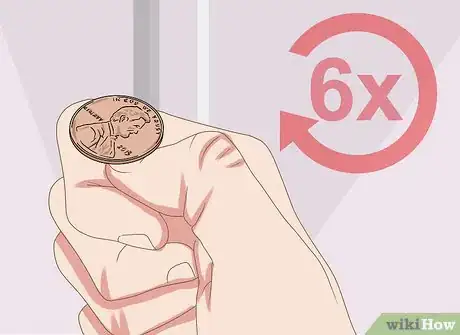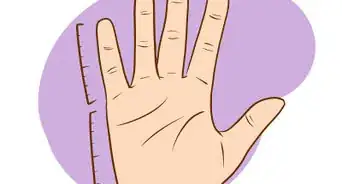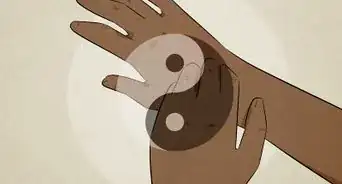This article was co-authored by wikiHow Staff. Our trained team of editors and researchers validate articles for accuracy and comprehensiveness. wikiHow's Content Management Team carefully monitors the work from our editorial staff to ensure that each article is backed by trusted research and meets our high quality standards.
wikiHow marks an article as reader-approved once it receives enough positive feedback. In this case, several readers have written to tell us that this article was helpful to them, earning it our reader-approved status.
This article has been viewed 287,982 times.
Learn more...
The I Ching (or Yi Ching or Book of Changes) is most commonly known as an ancient Chinese method of divination. In the past it was consulted using Yarrow sticks, but a common way to consult the I Ching is to toss three coins, assign a certain value to them, record the value, and repeat a total of six times to create a hexagram. It’s most useful to have a specific, open-ended question in your mind as you consult the I Ching because it does not return yes or no answers.
Steps
Casting the Coins
-
1Gather your coins. You can consult the I Ching with whatever coins you have handy. Pennies are a good option. If you want to add significance to the process, you can use coins minted in years that mean something, such as your birth year. You can also purchase old Chinese coins if you want to add authenticity to the process.[1]
- If you consult the I Ching on a regular basis, it is good to keep these three coins especially for this purpose. You can store them in a small pouch so they won’t get mixed up with your everyday change.
-
2Write down your question. The I Ching is intended for gaining some clarity about a specific dilemma that you are facing, so it is important to have a clear and simple question. Write down your question and continue to look at it and think about it as you perform the consultation.[2]
- It is better to use an open-ended question versus a yes/no question. For example, “Will I become rich?” might not yield as clear results as “What will my finances look like this year?”
- You also don’t want to think and write a complex question with too many parts. Rather than writing, “Would it be better to travel to Bermuda for my honeymoon or should I save the money to put a down payment on a house?” you could try “What will happen if I travel to Bermuda for my honeymoon?”
Advertisement -
3Toss the coins. You can shake the coins in your hand briefly and then gently toss them onto a smooth surface. It might work well to throw the coins into the lid of a box so that the coins do not roll all over the place.[3]
- The exact method you use for this step is up to you. As long as you don’t look at the coins to try to get them to fall in a certain way. You could even shake them in your hand and simply lay your hand flat on the table letting them fall.
Finding Your Hexagram
-
1Assign a number. Each toss of the coins will add up to a certain amount. Assign a value of three to any coins that are heads and two to any coins that are tails. Your roll will add up to 6, 7, 8, or 9. Three heads add up to 9. Two heads and 1 tail add up to 8. One head and two tails add up to 7. Three tails add up to 6.[4]
-
2Learn the meaning of the numbers in the I Ching. Each number corresponds to a few things in the I Ching system. The sum of the numbers designated to each side of the coin determines the yin or yang of the line, whether it is changing or unchanging, and whether it is a broken or unbroken line.
- 6 (3 tails) is considered a changing yin and is drawn as a broken line with an X in the middle. 9 (3 heads) is considered a changing yang and is drawn as a solid line with a circle in the middle.
- 7 (2 tails, 1 head) is considered an unchanging yang, and is drawn as a solid line. 8 (2 heads, 1 tail) is considered an unchanging yin and is drawn as a broken line.
-
3Repeat the process six times total. Use the coins to come up with six lines, which are called your hexagram. Each time, throw the coins, record the number and the line type. Put the first line as the bottom and draw each successive line above the previous one.
- For some I Ching guides, you can use the total “score” that your numbers added up to to find the hexagram value, rather than the line pattern. If you get six 6s, this would add up to 36. Six 9s would add up to 63.
Interpreting Your Hexagram
-
1Consult a guidebook. There are 63, or in some systems 64, variations of the hexagram pattern. If you have an I Ching book, you can read the meaning of your specific hexagram. There have been dozens of translations of the ancient text. The Wilhelm-Baynes translation is one of the most influential.
- If you don’t already have a copy, and you don’t want to buy one, visit your local library and check the book out or consult while you are at the library.
- The basic way of interpreting your hexagram is matching up the pattern with the list of possible patterns and reading the description of what that pattern represents.
-
2Find an online list of hexagram interpretations. Since the I Ching is an ancient text, you can find many websites with comprehensive lists of possible hexagram variations. These will offer interpretations of what the meaning of your hexagram could be.[5]
- The I Ching is not meant to give exact answers to your questions, so it is okay to trust an online I Ching guide.
-
3Enter your results into a hexagram calculator. Some websites allow you to input the results of each of your coin tosses by selecting the line that showed up. Once you enter all six lines, it will locate the proper hexagram for you and give you the meaning.[6]
- For example, if your hexagram numbers added up to 45, you would enter that and receive the interpretation of “Meeting” from the I Ching.
Community Q&A
-
QuestionWhy do the explanations for each line even exist if I'm only supposed to read the moving lines?
 Community AnswerBecause the requirement for having an interpretation for each line is necessary in the event of it being a changing line. If the third line is changing in one reading, it may not be the next time. If no interpretation exists, how will you read it if the changing line in your next reading is the first line? And in fact, you could have a reading with all lines being changing, but there are rules for determining which changing line prevails. And of course, there is the reading with no changing lines at all, so only the general interpretation is applicable.
Community AnswerBecause the requirement for having an interpretation for each line is necessary in the event of it being a changing line. If the third line is changing in one reading, it may not be the next time. If no interpretation exists, how will you read it if the changing line in your next reading is the first line? And in fact, you could have a reading with all lines being changing, but there are rules for determining which changing line prevails. And of course, there is the reading with no changing lines at all, so only the general interpretation is applicable. -
QuestionHow I can read the result of the hexagon?
 Community AnswerIt involves a few steps, including finding the changing lines, mapping the hexagon to the corresponding chapter or paragraph of I Ching. The 'Consult I Ching' app offers a convenient way to do so. You can find it in both App Store and Play Store by searching 'Consult I Ching'.
Community AnswerIt involves a few steps, including finding the changing lines, mapping the hexagon to the corresponding chapter or paragraph of I Ching. The 'Consult I Ching' app offers a convenient way to do so. You can find it in both App Store and Play Store by searching 'Consult I Ching'.
Things You'll Need
- 3 coins
- pen and paper
References
- ↑ https://exemplore.com/fortune-divination/I_Ching_divination
- ↑ http://dreamhawk.com/i-ching/how-to-throw-the-coins-to-obtain-a-reading-for-the-i-ching/
- ↑ http://www.serenapowers.com/yijing.html
- ↑ https://www.onlineclarity.co.uk/learn/beginners/3-how-to-cast-a-reading/casting-a-hexagram-with-3-coins/
- ↑ http://divination.com/iching/lookup/
- ↑ https://www.eclecticenergies.com/iching/lines.php
About This Article
To consult the I Ching method, all you need are 3 coins. Write down a simple, coherent question and always expect an open-ended answer. You will need to cast the coins a total of 6 times, but before you do so, note that their numerical value is 3 for heads and 2 for tails, as well as what types of yin and yang energy result from summing them up. Use that knowledge to draw out a hexagram by adding together the 6 coin tosses. Scroll down for detailed steps on creating a hexagram and some tips on existing guidebooks that will help you interpret its patterns.







































































